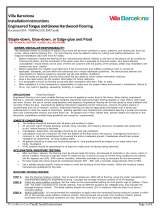Page is loading ...

• Choosing the right surface—The type of wood can make a
big difference in the look of the final repair. Choose a surface
as close to the “Natural” color of the wood filler you will
apply. Wood with heavy grain will show a repair area more.
Choose a wood with less grain and test it first to make sure
you have a good color and stain match.
• Preparing the surface—Surface should be clean and dry.
De-gloss the surface if necessary.
Surface, wood filler, and air temperature should be above 40ºF.
If you’ll be staining the wood, make sure to stain before filling
with wood filler. Once the filler is dried and sanded, you will
go back and stain the wood filler.
If you want to limit the areas around a fill that will need to
be sanded, use painter’s tape to keep those areas protected.
• Press filler into place with putty knife. For deep gouges
larger than ¼” in depth, multiple layers are recommended
instead of a single fill. Overfill slightly to allow for sanding
or settling.
• If you are using Plastic Wood on an exterior surface,
or on a surface that you will place outside, make sure
to choose a surface that will be painted, stained with a
solid color stain, or otherwise sealed. Unpainted wood
(on any side—even the underside
of a deck) will take in moisture
which can cause a lot of expansion
and contraction that will limit the
durability of your repair over time.
®
ALL PURPOSE WOOD FILLER
Here are some handy
ApplicationTips
that we’ve found helpful:
Before You Fill
A commonly-seen mistake occurs when there is a
small, open area between the edge of the filler and the
wood where stain can pool up and soak into the wood.
This results in the appearance of a dark ring around the
repair.
If you stain the wood to be repaired first, this will prevent
a ring since stained wood does not accept as much stain
as unstained wood.
Make sure you overfill and sand well to get a seamless
repair.
Plastic Wood should be applied by slightly overfilling the
surface to allow for sanding and settling.
T
Be on the look-out for this icon throughout—it signals one of our
“Tips + Tricks” developed by product experts to help ensure a
successful application.
How to Apply
T
See and tips on reverse.
Finishing Clean-Up

• All Plastic Wood filler can be sanded, painted and stained.
• Sanding—Once cured, the filled surface should be sanded
flush to remove the excess and leave a smooth finish.
Allow to dry approximately 2 to 6 hours for shallow fills and
36 hours for deeper fills.
Wood filler will change color from pink to natural to indicate
the surface is ready to be sanded. Sand with medium-grit
sandpaper.
• Painting + Staining (required for all exterior surfaces)—make
sure to paint, stain (with a solid color stain) or otherwise seal
your final project.
Repaired surfaces can be painted with latex-based paint
immediately after sanding, or after 12 hours using an oil-
based paint.
• Before the product cures—use a wet paper towel or rag to
clean areas around the repair for a clean look.
• After Plastic Wood cures—use sandpaper to remove any
excess residue.
• Reseal tightly with lid after each use.
Finishing Clean-Up
When placing a screw into a cured Plastic Wood repair, always
pre-drill a pilot hole to avoid placing too much stress on the
patch.
Plastic Wood should not be used to repair flexible surfaces.
The color of the wood filler in the tube does not reflect the cured
color as it will dry slightly darker.
T
Questions? We’re here to help.
Give our DAP TIPS Help Line a call
Monday–Friday, 8 am–5 pm,
or Saturdays from 9 am–6 pm, Eastern.
1-888-DAP-TIPS
For trim with fine detail and/or rounded edges, sanding
sponges with beveled edges can help you sand more precisely
and achieve virtually invisible repairs.
T
®
plasticwood.dap.com
/

